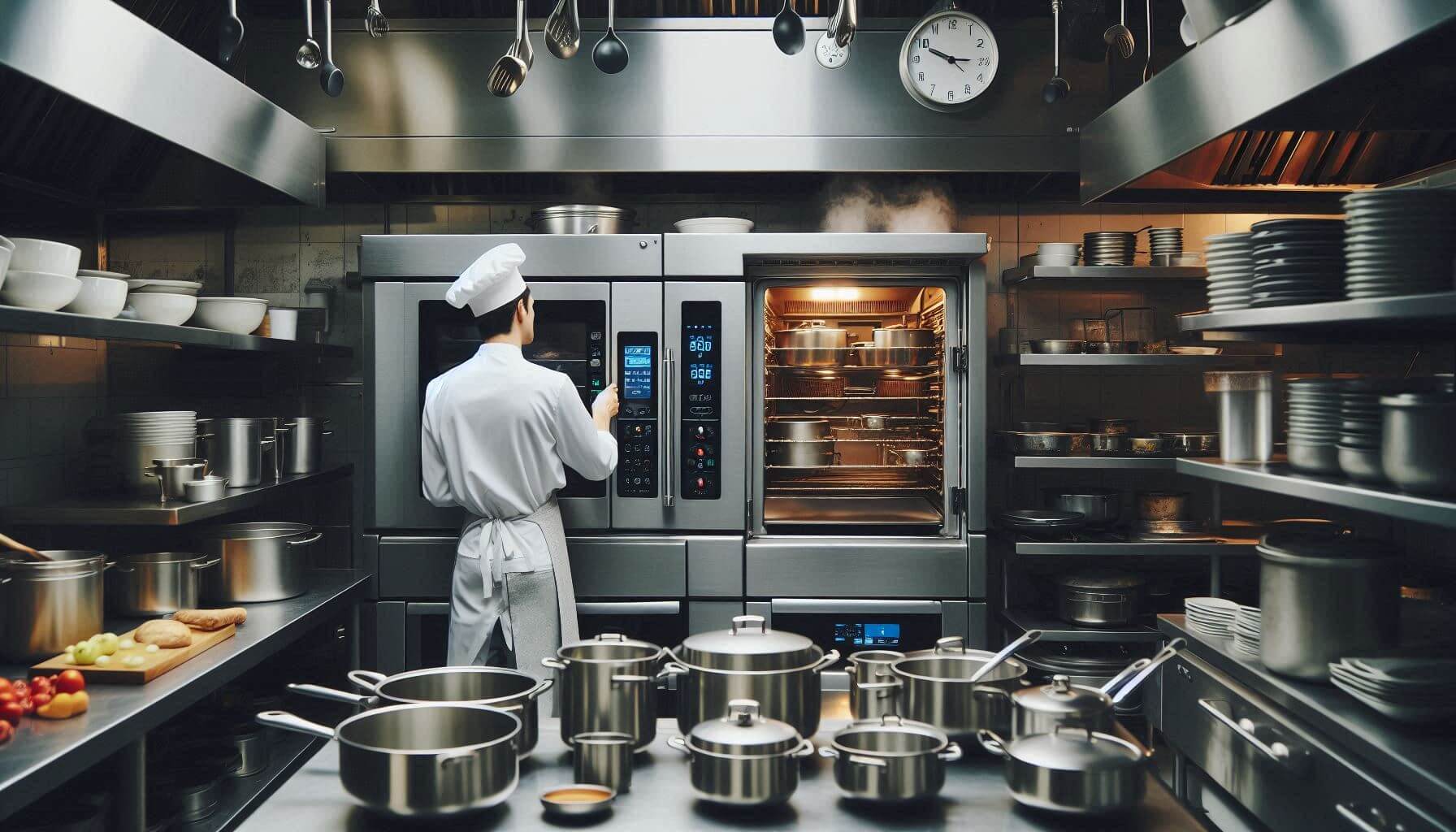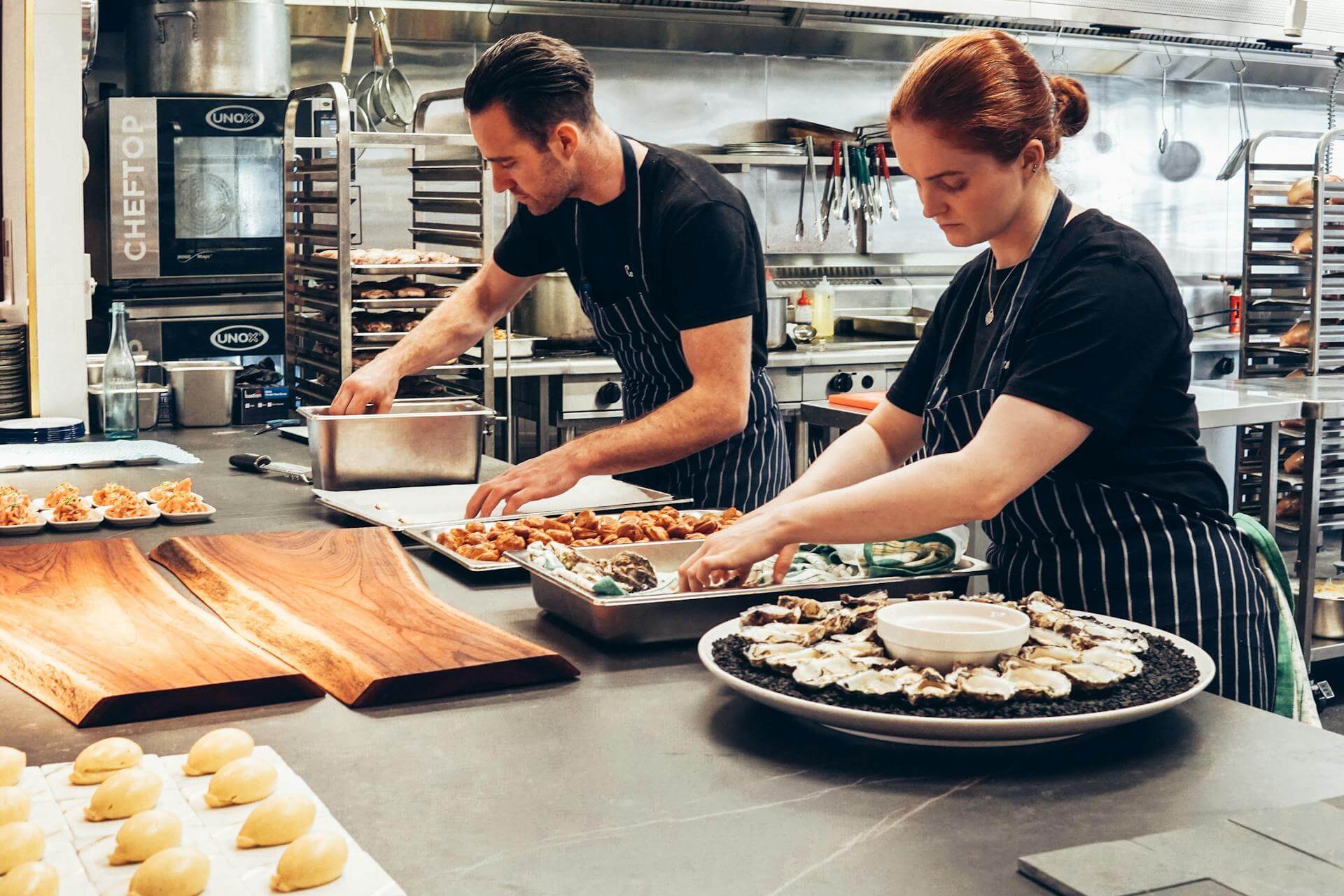The Comprehensive Guide to Combi Ovens: Efficiency, Versatility, and Performance
by Nathen Dubé

That’s some impressive AI-generated commercial kitchen equipment.
The versatility of combi ovens stems from their ability to combine multiple cooking methods into a single unit, making them a must-have for any professional kitchen.
These appliances have revolutionized the way we cook in the dynamic realm of modern kitchens.
In this comprehensive guide, we’ll explore the efficiency, versatility, and performance of combi ovens, helping you understand why they’re essential for contemporary culinary success.
What is a Combi Oven?
Definition and Basic Functionality
A combi oven is a kitchen powerhouse that combines convection, steam, and a mix of both cooking methods.
This multipurpose bit of kitchen kit can bake, roast, grill, steam, and even sous-vide. With such incredible functionality and versatility, combi ovens are indispensable for any culinary operation.
History and Evolution
Introduced in the 1970s, the combi oven has come a long way from its humble beginnings.
Early models were basic convection ovens with a simple steam function. Today, they boast advanced features like programmable settings, precise temperature and humidity controls, and smart technology integration.
The evolution of combi ovens has been marked by several key innovations. Initially, combi ovens were large, cumbersome units that required significant space and manual operation. However, as technology advanced, these ovens became more compact, efficient, and user-friendly. The introduction of digital controls, touchscreens, and programmable settings has made it easier for chefs to achieve precise cooking results with minimal effort.
Key Components and Features
Modern combi ovens are equipped with several advanced components.
- Fan and Motor: Ensures even heat distribution. The fan circulates hot air around the food, allowing for uniform cooking and browning.
- Steam Generator: Produces steam for moist cooking. This feature is essential for steaming vegetables, fish, and other delicate items without drying them out.
- Touchscreen Interface: For easy programming and monitoring. Chefs can set specific cooking times, temperatures, and humidity levels with just a few taps on the screen.
- Temperature and Humidity Sensors: For precise control over cooking conditions. These sensors ensure that the oven maintains the desired environment, leading to consistent results.
The Versatility of Combi Ovens
Range of Cooking Methods
Combi ovens excel in offering diverse cooking methods, including those below.
- Steaming: Perfect for vegetables, seafood, and delicate items. Steaming helps retain nutrients and natural flavors while ensuring even cooking.
- Baking: Ideal for bread, pastries, and desserts. The convection function provides even heat distribution, resulting in perfectly baked goods.
- Roasting: Achieves a crispy exterior while keeping the interior moist. This method is great for meats, poultry, and root vegetables.
- Grilling: Adds a charred flavor to meats and vegetables. The high heat of the grill function sears the outside, creating a delicious crust.
- Sous-Vide: Ensures precise temperature control for slow cooking. This method involves cooking food in a vacuum-sealed bag in a water bath, resulting in tender and flavorful dishes.
Examples of Dishes
Combi ovens can handle a variety of dishes, demonstrating their versatility.
- Roast Chicken: Achieve a golden, crispy skin while keeping the meat juicy and tender.
- Steamed Fish: Cook delicate fish fillets to perfection, preserving their texture and flavor.
- Croissants and Baguettes: Bake flaky, golden pastries with consistent results.
- Grilled Vegetables: Enhance the natural flavors of vegetables with a slight char.
- Sous-Vide Steaks: Cook steaks to the perfect level of doneness with precise temperature control.
Combi Oven Benefits
Combi ovens are versatile enough to benefit various culinary environments.
- Restaurants: Handle high-volume orders efficiently. Chefs can prepare multiple dishes simultaneously, reducing wait times, and improving service.
- Catering: Provide versatility for diverse menus. Caterers can offer a wide range of dishes without needing multiple appliances.
- Hotels: Ensure consistent quality for large-scale food service. Hotel kitchens can maintain high standards across various meal services, from breakfast buffets to fine dining.
Comparison to Traditional Cooking Equipment
Compared to traditional ovens and steamers, combi ovens are more energy-efficient and cost-effective. They reduce the need for multiple appliances by combining cooking methods into one.
This consolidation leads to lower energy consumption, and reduced operational costs.
How Combi Ovens Save Energy
Combi ovens save energy through several mechanisms.
- Reduced Cooking Time: Faster cooking with combined methods. The combination of convection and steam accelerates the cooking process, reducing overall energy use.
- Efficient Heat Distribution: Even cooking reduces energy waste. The fan and motor ensure that heat is distributed evenly, eliminating hot spots and undercooked areas.
- Programmable Settings: Optimize energy use for different recipes. Chefs can program the oven to use the most efficient cooking method for each dish, minimizing energy consumption.
Impact on Food Waste Reduction and Sustainability
Combi ovens contribute to sustainability in several ways.
- Reducing Food Waste: Precise cooking reduces overcooking and waste. The ability to control temperature and humidity accurately ensures that food is cooked to perfection, minimizing leftovers and discarded items.
- Lower Utility Costs: Efficient energy use lowers bills. The reduced cooking time and optimized energy consumption lead to significant savings on utility bills.
- Sustainable Cooking Practices: Support eco-friendly kitchen operations. By using less energy and reducing food waste, combi ovens help kitchens operate more sustainably.
Maintenance Tips and Best Practices
Daily and Weekly Maintenance Routines
Regular maintenance ensures optimal performance and longevity.
- Daily: Clean the interior and exterior surfaces, empty the drip tray, and check the door seals. Wipe down the touchscreen interface to keep it responsive.
- Weekly: Descale the steam generator, clean the fan and motor, and inspect all components for wear and tear. This routine helps prevent buildup, and ensures the oven operates efficiently.
Cleaning and Descaling Tips
Proper cleaning and descaling are crucial for maintaining the combi oven’s performance.
- Cleaning: Use non-abrasive cleaners and soft cloths. Avoid harsh chemicals that could damage the oven’s surfaces or components.
- Descaling: Follow manufacturer instructions for descaling solutions and procedures. Regular descaling prevents mineral buildup that can affect the steam generator’s performance.
Troubleshooting Common Issues
Address common issues promptly to avoid downtime.
- Inconsistent Cooking: Check temperature settings and fan operation. Ensure the oven is preheated properly, and that the fan is distributing heat evenly.
- Steam Issues: Inspect the steam generator and descaling schedule. Regular descaling can prevent steam production problems.
- Error Codes: Refer to the user manual for specific error resolutions. Most combi ovens have built-in diagnostics to help identify and resolve issues.
Importance of Regular Professional Servicing
Professional servicing ensures longevity and performance. Schedule regular check-ups with certified technicians to keep your combi oven in top condition.
These experts can identify potential issues before they become major problems, and ensure that the oven operates at peak efficiency.
Choosing the Right Combi Oven
When selecting a combi oven, consider several key factors:
- Size and Capacity: Match the oven size to your kitchen’s needs. Smaller kitchens may benefit from compact models, while larger operations may require higher-capacity units.
- Features: Look for advanced controls, programmability, and energy efficiency. Consider features like multi-stage cooking, recipe storage, and automatic cleaning functions.
- Brand Reputation: Choose reputable brands known for quality and reliability. Research customer reviews and industry recommendations to find a trusted manufacturer.
- Budget: Balance cost with the oven’s features and benefits. While high-end models may offer more advanced features, there are also budget-friendly options that provide excellent performance.
Case Studies and Expert Recommendations
Explore success stories from top chefs and kitchens to see how combi ovens have transformed their culinary operations. For example, a renowned restaurant may use a combi oven to streamline its kitchen workflow, resulting in faster service and improved dish consistency.
Insights from industry experts can guide your decision, offering tips on selecting and using the best combi oven for your needs. Interviews with chefs who have integrated combi ovens into their kitchens successfully can provide valuable perspectives on maximizing the benefits of these appliances.
Integration and Practical Tips
Smooth integration involves several steps.
- Space Planning: Ensure adequate space for the oven and ventilation. Measure the available area, and consider the oven’s dimensions. Include any clearance needed for door opening, and maintenance access.
- Electrical and Plumbing: Confirm compatibility with your kitchen’s infrastructure. Check that the oven’s electrical requirements match your kitchen’s power supply, and that you have the necessary plumbing connections for the steam generator.
- Workflow Optimization: Position the oven for easy access and efficiency. Consider the flow of your kitchen operations, and place the oven where it can be reached by chefs and kitchen staff easily.
Training Staff for Optimal Use
Proper training is essential for maximizing the benefits of a combi oven.
- Hands-On Training: Provide practical demonstrations for staff. Show them how to operate the oven, program settings, and use different cooking methods.
- User Manuals: Ensure staff are familiar with the oven’s features and controls. Distribute user manuals, and provide training sessions to cover all aspects of the oven’s operation.
- Ongoing Education: Update training regularly as new features or recipes are introduced. Continuous education helps staff stay proficient with the oven, and explore new cooking techniques.
Maximizing the Benefits in Daily Operations
To fully leverage a combi oven, consider the following tips.
- Menu Planning: Design menus that utilize the oven’s versatility. Incorporate dishes that can be prepared using different cooking methods to showcase the oven’s capabilities.
- Batch Cooking: Optimize batch sizes for efficiency. Use the oven’s capacity to cook multiple dishes at once, reducing cooking time and energy use.
- Monitoring and Adjustments: Monitor cooking processes continually, and adjust for consistency. Check the oven’s performance regularly, and fine-tune settings to achieve the best results.
Conclusion
Combi ovens are a cornerstone of modern kitchen efficiency, offering unparalleled versatility and performance. By incorporating a combi oven into your kitchen, you can enhance creativity, improve operational efficiency, and achieve consistent, high-quality results. Explore your options and consult with experts to find the perfect combi oven for your culinary needs.
The benefits of combi ovens extend beyond just cooking versatility. Their energy efficiency, cost-effectiveness, and impact on food waste reduction make them an excellent investment for any kitchen.
With proper maintenance and staff training, a combi oven can transform your culinary operations, delivering delicious results every time. Whether you’re a restaurant, catering service, or hotel, a combi oven can elevate your kitchen’s capabilities and help you meet the demands of modern dining.
Image: Microsoft Designer


